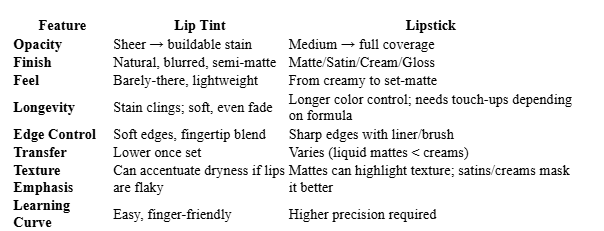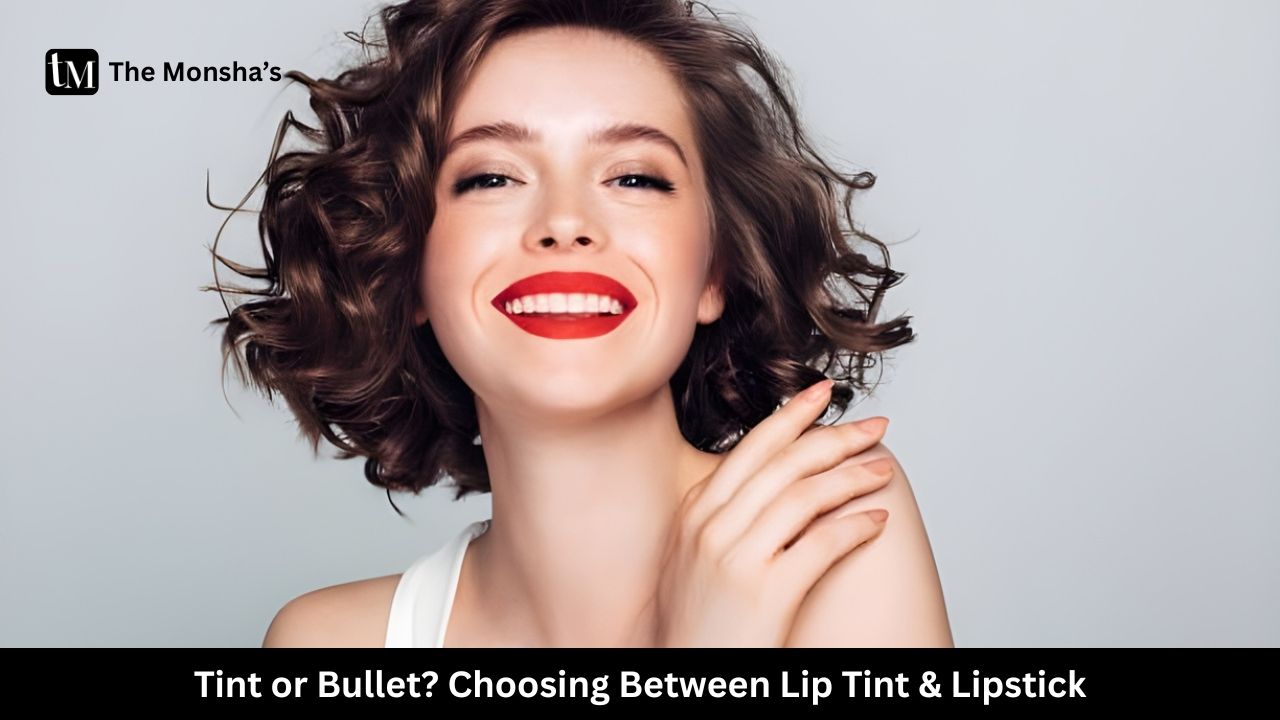TL;DR
Lip tints = lightweight, natural-looking stain with comfy wear and soft fades. Lipsticks = bolder color, cleaner edges, and finish control (matte/satin/cream). Neither is universally “better”—pick based on your lip condition, time of day, event length, and maintenance tolerance. Power move? Layer: stain with a tint, lock edges with liner, add a whisper of lipstick in the center for depth. “Bas itna samajh lo—mood ke hisaab se product, aur lips khush!” 😉
Introduction – The 8:30 a.m. Lip Crisis 😮💨
You’re late, your coffee’s cold, and your lips are giving raisin vibes. Do you swipe a tint for that “I woke up like this” flush, or go full lipstick for a boss-level finish? As a chronically sleepy beauty blogger who’s tested far too many tubes, here’s the tea: both are brilliant—when used right. Let’s decode, minus the fluff.
What Exactly Are Lip Tint & Lipstick?
Lip Tint (the “your lips but alive” color)
- Usually water/gel-based with dye-like pigments that lightly stain the lip.
- Sheer-to-buildable; feels weightless, often looks semi-matte once set.
- Minimal wax = less slip, more natural diffusion.
Lipstick (the classic color vehicle)
- Waxes + oils + pigments = structure, glide, and impact.
- Finishes: matte, satin, cream, glossy, liquid long-wear.
- Precision-friendly and camera-ready when you need crisp edges.
Reality check: Lab tests on color cosmetics routinely show that film-formers and volatile carriers enhance lipstick longevity, while low-wax, water-based stains give tints their feather-light feel and even fade. (No report names—just the gist.)
Key Differences (Fast Comparison) 📊

Plain-speak: Tints look like healthy lips. Lipstick looks like intentional makeup. Dono ka apna time & place. “Kabhi tint, kabhi tint ke upar lipstick—dono saath chale toh maza aa jaye.” 😌
When To Use Which (Situational Guide)
Everyday / Zoom / Errands
- Pick: Tint.
- Why: Quick, low-maintenance, survives sips and small snacks with a pretty fade.
Long Meetings / Photos / Events
- Pick: Lipstick (liquid long-wear or matte-satin).
- Why: Cleaner edges, stronger pigment, predictable wear.
Dry / Flaky Lips
- Pick: Satin/cream lipstick or tint over balm.
- Why: Creams cushion texture; tints alone may cling to flakes.
Humid, Hair-Down Days
- Pick: Tint or satin lipstick.
- Why: Less slip than gloss; fewer “hair-on-lip” jump scares.
Minimal Makeup Aesthetic
- Pick: Tint (cheeks + lips).
- Why: Monochrome, soft-focus vibe in 30 seconds.
How to Apply (So It Actually Lasts)
Lip Tint – Soft-Stain Method
- Prep: Gentle scrub, thin balm, blot.
- Center First: Dot in the middle, blend outward with fingertip/brush.
- Set: Let it dry; add second thin layer if needed.
- Seal (optional): A tap of balm if lips feel tight.
Pro notes: Newer tints use small-molecule dyes that sink for longevity; hydration under-layer keeps stain even.
Lipstick – Clean-Edge Method
- Prime: Scrub + balm → blot.
- Frame: Lip liner (match within 1–2 shades).
- Layer: Thin coat → blot → second coat.
- Refine: Clean edges with a tiny brush + concealer.
- Optional Pop: Micro dab of clear balm in the center for dimension.
Pro notes: Film-formers + silicones in many lipsticks reduce migration and increase wear—thin layers work better than one thick swipe.
Combo Tricks (Best of Both)
- Tint Base + Lipstick Center: Stain prevents “naked center” fade; lipstick adds depth.
- Lipstick Base + Tint Wash: Blur harshness, create soft-focus edges.
- Tint + Liner Only: Ultra-natural but structured “my lips but sharper.”
Pros, Cons & Risks (Be Honest)
Lip Tint
- Pros: Lightweight, natural, even fade, multi-use (cheeks).
- Cons: Can feel dry on flaky lips; some stains catch on cracks.
- Watch-outs: Alcohol-heavy formulas may sting; prep matters.
Lipstick
- Pros: Bold color, finish control, crisp shape, event-proof options.
- Cons: Transfer (creams), dryness (ultra-mattes), maintenance after meals.
- Watch-outs: Fragrance or strong pigments can irritate sensitive lips—listen to your skin.
Evidence snapshot: Consumer wear-tests consistently show tints fade more evenly while lipsticks provide superior edge definition and shade accuracy. No report names—just the takeaway.
Real-World Wear Timeline ⏱️
- Hour 0–2: Tint = fresh flush; Lipstick = peak saturation.
- Hour 3–4: Tint = pretty stain remains; Lipstick = softens, edges intact (with liner).
- Post-meal: Tint = stain survives light meals; Lipstick = reapply center or full (liquid mattes survive better with blot-first trick).
- End of day: Remove gently, re-nourish. “Raat ko balm bhool gaye toh subah complaint pakki.” 😅
Quick Decision Table (Cheat Sheet) 🧭

Conclusion – The Verdict (No Drama, Just Facts)
Both belong in your kit. Tint is the effortless flush that survives your third chai. Lipstick is the power suit that photographs like a dream. If you want to win Tuesdays and weddings alike, layer smart: stain for backbone, liner for borders, lipstick for personality. “Makeup ka kaam: mood ko match karna, math nahi.” 💁♀️
FAQs 🙋♀️
Q1. Can I make my lipstick look like a tint?
Yes—apply, blot hard with tissue, then press a thin layer of balm on top. Soft-focus stain unlocked.
Q2. Are all tints long-lasting?
No. Water/gel tints with strong dyes last longer; balmy “tints” behave more like sheer lipsticks.
Q3. Which is better for dry lips?
Satin/cream lipsticks or a tint layered over balm. Avoid ultra-matte or alcohol-heavy tints on flaky days.
Q4. Can I layer lipstick over tint?
Absolutely. Let the tint dry first. Use lipstick mainly in the center for depth and comfy feel.
Q5. Do tints stain teeth?
If overly wet on application, they can transfer. Let it set; purse lips on a tissue before heading out.
Q6. Do I need liner with tint?
Not always. For soft looks, skip. For crisp edges or asymmetry correction, a nude liner works wonders.


